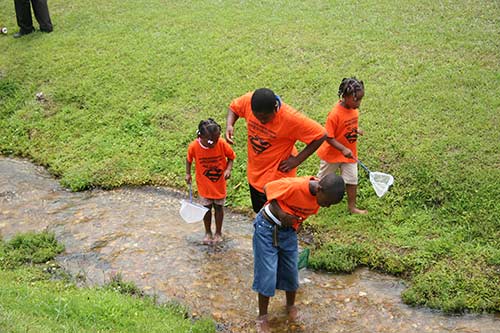When I was thirteen, I spent a summer as a volunteer at a giant orphanage in Washington, DC. Every child was African-American, and from an extremely disadvantaged background. Every one had surely experienced unspeakable trauma: death or desertion of parents, abuse, and neglect.
I was assigned to work with fourth and fifth grade boys. We played games, sang songs, did crafts, and generally had a good time. There was a kind volunteer coordinator who gave each of us volunteers a few materials and suggestions, but otherwise, as I recall, each one or two of us volunteers, age 13 to 16, was responsible for about 20 kids, all day.
I know this sounds like a recipe for chaos and disaster, but it was just the opposite. The kids were terrific, every one. They were so eager for attention that everywhere I went, I had three or four kids hanging on to me. But the kids were happy, engaged, loving, and active. I do not recall a single fight or discipline problem all summer. I think this summer experience had a big impact on my own choice of career.
 https://robertslavinsblog.files.wordpress.com/2018/08/blog_8-9-18_campkids_500x333.jpg?w=150&h=100 150w, https://robertslavinsblog.files.wordpress.com/2018/08/blog_8-9-18_c... 300w" sizes="(max-width: 607px) 100vw, 607px" />
https://robertslavinsblog.files.wordpress.com/2018/08/blog_8-9-18_campkids_500x333.jpg?w=150&h=100 150w, https://robertslavinsblog.files.wordpress.com/2018/08/blog_8-9-18_c... 300w" sizes="(max-width: 607px) 100vw, 607px" />
There are two reasons I bring up Junior Village. First, it is to reinforce the experience that most elementary school teachers have, even in the most challenged and challenging schools. There are many problems in such schools, but the kids are great. Elementary-aged kids everywhere respond positively to just a little kindness and attention. I’ve visited hundreds of elementary schools over my career, and with few exceptions, these are happy and productive places with sweet and loving kids, no matter where they are.
Second, the observation that elementary-aged children are so wonderful should make it clear that this is the time to make certain that every one of them is successful in school. Middle and high school students are usually wonderful too, but if they are significantly behind in academics, many are likely to start a process that leads to disengagement, failure, acting out, and dropping out.
Evidence is mounting that it is possible to ensure that every child from any background, even the most disadvantaged, can be successful in elementary school (see www.evidenceforessa.org). Use of proven whole-school and whole-class approaches, followed up by one-to-small group and one-to-one tutoring for those who need them, can ensure success for nearly all students. A lot can be done in secondary school too, but building on a solid foundation from sixth grade forward is about a million times easier than trying to remediate serious problems (a privileged glimpse into the perfectly obvious).
Nationwide, we spend a lot more on secondary schools than on elementary schools. Yet investing in proven programs and practices in elementary school can ensure uniformly successful students leaving elementary school ready and eager to achieve success in secondary school.
I remember participating many years ago in a meeting of middle school principals in Philadelphia. The district was going to allocate some money for innovations. A district leader asked the principals if they would rather have the money themselves, or have it spent on improving outcomes in the elementary grades. Every one said, “Spend it early. Send us kids who can read.”
If you think it is not possible to ensure the success of virtually every child by the end of elementary school, I’d encourage you to look at all the effective whole-school, whole-class, one-to-small group, and one-to-one tutoring programs proven effective in the elementary grades. But in addition, go visit kids in any nearby elementary school, no matter how disadvantaged the kids are. Like my kids at Junior Village, they will revive your sense of what is possible. These kids need a fair shot at success, but they will repay it many times over.
Photo credit: By U.S. Fish and Wildlife Service Southeast Region [CC BY 2.0 (https://creativecommons.org/licenses/by/2.0) or Public domain], via Wikimedia Commons
This blog was developed with support from the Laura and John Arnold Foundation. The views expressed here do not necessarily reflect those of the Foundation.
You need to be a member of School Leadership 2.0 to add comments!
Join School Leadership 2.0